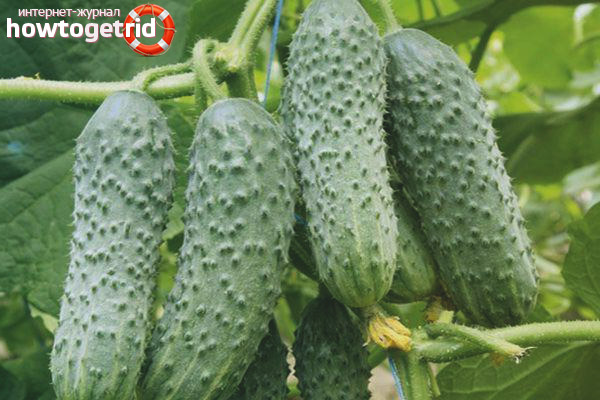The content of the article
To breed a new Mamluk variety, breeders crossed several types of cucumbers. This species belongs to the hybrid group. For a short period, the variety acquired its admirers, and is in demand among gardeners and farmers. Experts say that you can grow cucumbers both in greenhouses of various types and in open ground. A feature of the variety is the ability to plant seeds twice a season. The first time cucumbers are planted in the spring, the second time in the middle of summer.
The variety has unpretentiousness to weather conditions and care, has a stable immunity to various fungal infections, suitable for cultivation on an industrial scale. Cucumbers grow early, about 45-50 days after sowing seeds. The fruiting period reaches 2 months. The variety is self-pollinating, therefore, does not require the intervention of bees and humans. Cucumbers feel great in greenhouse structures and in beds in the garden.
Grade description
The bushes are medium-sized, the lashes grow well. The length of the main shoot reaches 2 meters, and the lateral stems grow to 1 meter. The leaves of saturated green color, large, have the shape of a heart. The surface of the leaves is rough. Plants have a predominantly female type of flowering. Inflorescences are formed by bunches, in each 2-3 fruits are tied.
Fruits are small in size. The skin color is bright green with white stripes. The shape is oval, on the surface of the skin well-defined tubercles with white spikes are visible. The length of one cucumber reaches 10-12 cm. The pulp is dense, uniform, with a crunch. The seeds are small.
The variety has good yield and quality fruits. Subject to the rules for cultivation and care, from one square meter you can collect 11-14 kg of healthy fruits. Thanks to the dense skin, cucumbers are suitable for long-term storage, as well as for transportation to other regions by trading companies.
Care Rules
Watering
Vegetables belonging to the pumpkin family should be regularly and moderately watered. You need to do this with warm water so that the root system does not get too cold. Water consumption for irrigation depends on the stage of plant development. During fruit setting and at the beginning of fruiting, the amount of moisture consumed increases. So when watering, this fact should be taken into account.
Tap water contains chlorine impurities that adversely affect plants. Therefore, water is pre-settled. Watering is carried out 3 times a week. With the onset of rainy weather, water consumption is reduced.
Soil fertilizer
Cucumbers of this variety should be fed 4 times during the summer season:
- after sowing seeds before flowering plants;
- during flowering bushes;
- at the very beginning of the collection of the first cucumbers;
- during fruiting, to continue the process.
It is recommended to use minerals and organics for additional nutrition. The first supplement is prepared with chicken droppings. About 0.2 kg of litter is placed in a bucket and 10 liters of water are poured. The mixture is infused for about two days. The resulting concentrate in 1 cup is added to a bucket of warm water, and the plants are watered, preventing the solution from getting on the leaves and shoots.
The second and third feeding is carried out using medicinal plants and weed grass. Pour 10 liters of water per 1 kg of grass and leave for several days for fermentation.The resulting mixture is diluted in a bucket of water (1 liter of the resulting infusion per 10 liters of water). Cucumber beds are watered with this solution.
The fourth feeding is carried out using furnace ash. It is scattered under the bushes, deepened into the soil, and then watered. You can prepare a solution. Dissolve 1 glass of ash in a bucket of water. The solution is watering and spraying the leaves.
Pest and Disease Control
Mamluk variety, as described by the manufacturers, is quite resistant to diseases such as parasporosis and cladosporiosis. However, without additional preventive measures, plants can be affected by powdery mildew, fusarium or root rot. Several times during the summer it is recommended to carry out processing with special preparations that are sold in specialized stores.
To combat and prevent the invasion of harmful insects, often use folk proven means. Especially effective are infusions made from onion peel, on garlic, and on other plants with a strong repellent odor. Experienced gardeners are also advised to pay attention to the drug Haupsin. When spraying plants with this agent every 14 days, you don’t have to worry about “uninvited guests”.
Reviews gardeners
- Margarita Olegovna 41 years: Every year I try to plant different varieties of cucumbers. This year I purchased seeds of the Mamluk hybrid. Very unpretentious variety and high productivity. The fruits are tasty and aromatic. Fresh vegetable salad with such cucumbers is simply wonderful and fragrant. Cucumbers are suitable for canning.
- Daniil S., 65 years old: Different cucumbers are grown in the country. Sort Mamlyuk soot for the second year. I tie the scourges to the installed crossbar. I like the duration of fruiting varieties. We must not forget about fertilizers, and often carry out watering. Even if care rules are not followed, the harvest will be excellent. Several times I forgot to water the bushes. This did not affect the fruits. I decided to grow this variety every year.
Video: Mamluk F1 cucumbers










Submit